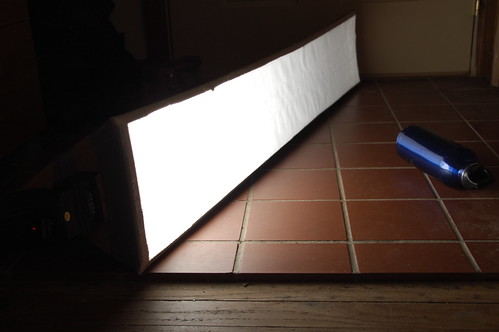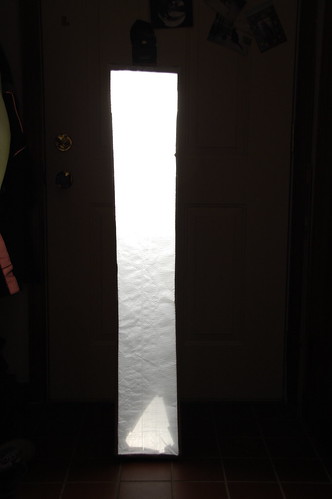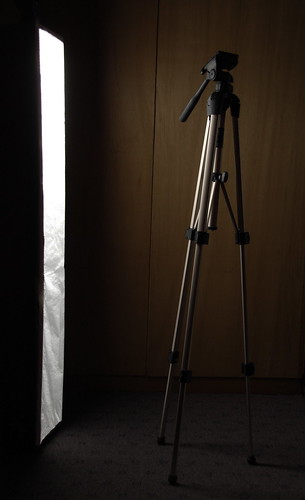I have been meaning to add another form of light to my studio kit. Since I am still wrestling with the whole money issue, I decided to DIY as inexpensively as I could. What I wanted was a light weight, portable soft box strip light. I figured it could be powered by my slaved Promaster strobe. Here is what I ended up with.
I started with a box I got out of the trash that measured 8" per side by 6' long. I cut it down to 4 feet long, then cut one side off so that I had a triangular box 8"x8"x8"x4'. One 8"x4' face I cut out except for a 1/2" strip all the way around the edge which I left for strength. Once all cut and ready to assemble back into a box that closed on each end, I cut an opening on the "top" into which I could jam my Promaster strobe (you can see the strobe in place in the photo above). So the construction of the box was nearly done. Next I spray painted the inside surfaces using chrome paint (high gloss silver). On the face I cut out, I securely taped some sturdy white plastic that also came from the trash (Menard's has interesting trash). The outside of this thing is NOT at all pretty.
But does it work?
I laid it on its side in the entry way of the house and put my water bottle about 18" away from it. Here is the result of the first test firing.
It appears my light is not too even, with brighter light showing at the top and less at the bottom. I think I will try making a bit of a cardboard snoot on the inside - just a couple of inches - to constrain the immediate light at the lens of the strobe. Should be an easy fix...
Total cost was under $4.00. $3.50 for the paint, about $0.25 worth of duct tape, and about two hours of time start to finish.
UPDATE: Well the snoot idea did not work. It left a very noticeable "snoot shape" and did not light the lower half of the box any better. Ripped it out. Plan C called for cutting a cheap spare mirror to fit the triangular shape and attach it to the bottom of the box, thus bouncing the light back up. Great idea, huh? Too bad it made zero appreciable difference. Well, I thought, maybe if I tilted it a bit so that it bounced the light forward towards the diffuser? Opened it up again and popped an upside down "V" of cardboard under the rear point of the mirror, raising it to approximately a 30 degree angle. Tested again, and well, see for yourself:
I clearly am bouncing some light, but not in any helpful way. The bottom half or so of the box is still noticeably darker than the strobe end. I'm having fun with these trials. It is helpful to remember Edison's quote, "I have not failed. I have found 1000 ways that do not work."
Any hints from readers? There have been a lot of you: over 40 in the past 3 hours, from an interesting array of locations. Thanks to Sitemeter, I know generally where you are (but not who).
UPDATE #2: I tried Chris' suggestion (in the comments) and bought a small roll of aluminum tape and applied it to the inside of the box, but only in the bottom half to see if its greater reflectivity would boost the light where it was weaker. I also left the mirror in, but laid it flat agains the bottom so that it simply bounces the light straight up. The answer is that it helped, but it didn't even it up as much as I wished. Regardless, I am calling it a completed experiment and will try it out on a model as soon as I get a chance. Here is a test shot on a tripod:
The light is nice and soft, and it should do just what I want it to. The final cost of the box is around $7.50, including the cost of the roll of alu tape.
Thursday, April 2, 2009
DIY Soft Box Strip Light
Subscribe to:
Post Comments (Atom)




Hey Nataraj! It's Chris.
ReplyDeleteDo you have another flash to put in the other end? It's going to be tough to get more light down the other end. But perhaps a floating mirror suspended between the flash and the front of the screen would help. (mirror facing the back, imagine a bounce card made of mirror, but about 4"x10") This would block some of the light from hitting the screen at the top end and it would have to bounce down lower.
I find aluminum tape helpful with these projects. They sell it near the duct tape.
Hi Chris. No other flash of a sort that is suitable. That would make it effective, but unable to free-stand. The alu tape is an interesting idea. I could cover the bottom half with the more reflective tape and leave the top half as is. That might even out the light.
ReplyDeleteThe floating mirror idea is interesting, but technically challenging with the materials used. I suspect I would get just a 4x10 dark spot near the top, much as I did with the cardboard snoot attempt. The snoot only blocked the flash to the front for about 3" and was open on the sides and back - basically it was a barn door. Not mirrored though.
What if you reflected the light the other way? Not out at the bottom but back into the reflective paint/tape? Would that even it out?
ReplyDeleteRob, Ottawa
Hey Rob, I did try that as well, and it didn't seem to make much difference either way. It is all DIY, and so I wasn't very scientific about bouncing the light, but I did fool around with it a bit. The end result was that it seemed to work OK, but not as expected.
ReplyDelete